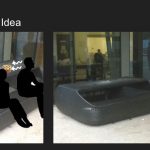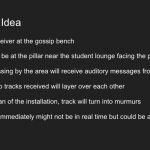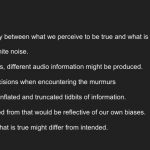What is sound?
I suppose upon reading Neuhaus’ article, sound itself is movement of waves in the air which becomes audible to an individual. Sound when composed in a lyrical sense would be contextualised as “music”, which with the workings of time signatures and proper rhythmic structure and symmetry bar structures would also be known as “a different way to tell time”. Sound art in its entirety form a different category on it’s own. It separates itself from music, losing most of it’s integral rules and constructs itself into anything that could make sound, or not, that is placed into the context of fine art.
How has it been use in culture and society?
The idea of sound has also been used culturally with phonographs to record and convey messages across time and space. The act of recording on a phonograph presents the idea of the background or surface noise, which Adorno relates the phenomenon to cinematic use known as “hear-strip”, the buzzing sound during the film recording of silence. DeMarinis’ article further states that as time goes, popular music begins to fill the void of silence with sound in fear of confronting it.
Likewise, various traditional cultures have continued the idea of “background noise”, such as in Carnatic Indian music, the tambura is used to generate a drone, a continuous base that carries the traditional art form through silences and movements. The Western classical equivalent would be the bass line which most famously, the Alberti bass would represent.
What makes it an art?
Sound art under the context of “fine art” transcends the notion of craftsmanship and ventures into an abstracted territory. As Neuhaus states that most of the time, sound art is not necessarily about sound, or about art itself. The comparison of creating a steel sculpture that generates sound, that is repurposed as sound art would only mean that any work of art producing a sound would be generalised as sound art.
While definitions are not entirely necessary, Neuhaus corrects the reader by informing that works of art that makes sound are mostly considered as “sound art” as a secondary label. Therefore, making it “an art” through association with it’s original intent.
How does advancement in audio technology affect our sense?
With the advancement of technology, in recordings and film, audiences require a void of silence to be filled. As mentioned previously, the fear of confronting silence is mediated with a buzzing sound known as the “hear-strip”
Neuhaus explains in 2000 that sound could be shaped to infinite possibilities, going beyond music. In retrospect, DeMarinis observes back in 1997 that artists like John Cage have gone as far as to use silence, as a form of reflection of the acoustics, causing an incredible tick to the listeners mentally, thus perpetuating the notion that the advancement in audio technology causes us to be unable to accept silence.
















